'Are these people f***ing crazy?': A 25th anniversary oral history of HBO's pioneering prison drama 'Oz'

Editor's Note: This oral history was originally published in 2017. It has been updated to reflect recent events.
As this year's Emmy nominations confirmed, HBO remains the center of the TV universe. Coupled with its streaming arm, HBO Max, the network racked up a whopping 140 nominations — far outpacing competitors like Netflix and Hulu — thanks to its current crop of buzzy shows like Succession, The White Lotus and Euphoria. HBO has been a prestige power player for so long, it’s hard to remember a time when it wasn’t the go-to destination for premium dramas. But turn back the clock 25 years, and you’ll find that it’s the house that Oz built.
Premiering on July 12, 1997, Tom Fontana’s groundbreaking prison drama proved to be a breakthrough hit for a network that was at that point best known as the place to watch post-theatrical run movies or the occasional cult comedy like Dream On or The Larry Sanders Show. But Oz was something else entirely — a bold and provocative experiment in storytelling and graphic content that could only have aired on a restrictions-free cable network looking to shake up its image.
“Back in 1997, who had HBO?” Oz star Dean Winters told Yahoo Entertainment in our expansive 2017 oral history of the show. “I didn’t. Did you? And given the content of the show, we were going to work thinking, "Are these people f***ing crazy? No one’s going to watch this."
Thankfully, Winters was proven wrong. Set in Emerald City, an experimental incarceration unit inside the fictional Oswald State Correctional Facility, the show quickly captured the attune of viewers and critics alike with its addictive fusion of gritty prison drama, dark comedy, graphic violence, and soap opera-esque romance. The show also boasted one of the finest ensembles around, with actors like J.K. Simmons, Eamonn Walker and Christopher Meloni passing through Emerald City’s glass cells over the course of its six-season run. Oz sent a clear signal to the industry at large that HBO was the place to nurture the next great generation of dramas. By the time the series ended in 2003, HBO had added The Sopranos, The Wire and Six Feet Under to its lineup, and truly earned its celebrated tagline: “It’s not TV. It’s HBO.”
For Oz's 20th anniversary, Yahoo TV talked with 13 key players in Oz‘s groundbreaking premiere and eight-episode first season. Read on to discover which famous hip-hop star played the role of narrator Augustus Hill before Harold Perrineau, what Oscar-winning legend Rita Moreno said when she learned she'd be playing a nun; and why no stunt asses were allowed on set.
The Participants (In Alphabetical Order)
Kirk Acevedo (Miguel Alvarez)
Adewale Akinnuoye-Agbaje (Simon Adebisi)
Chris Albrecht (CEO of Starz; Former CEO of HBO)
Jean de Segonzac (Director of Photography; Director)
Tom Fontana (Creator/Showrunner)
Ernie Hudson (Warden Leo Glynn)
Terry Kinney (Tim McManus)
Darnell Martin (Director)
Tim McAdams (Johnny Post)
Jon Seda (Dino Ortolani)
Lee Tergesen (Tobias Beecher)
Dean Winters (Ryan O’Reily)
Luna Lauren Velez (Gloria Nathan)
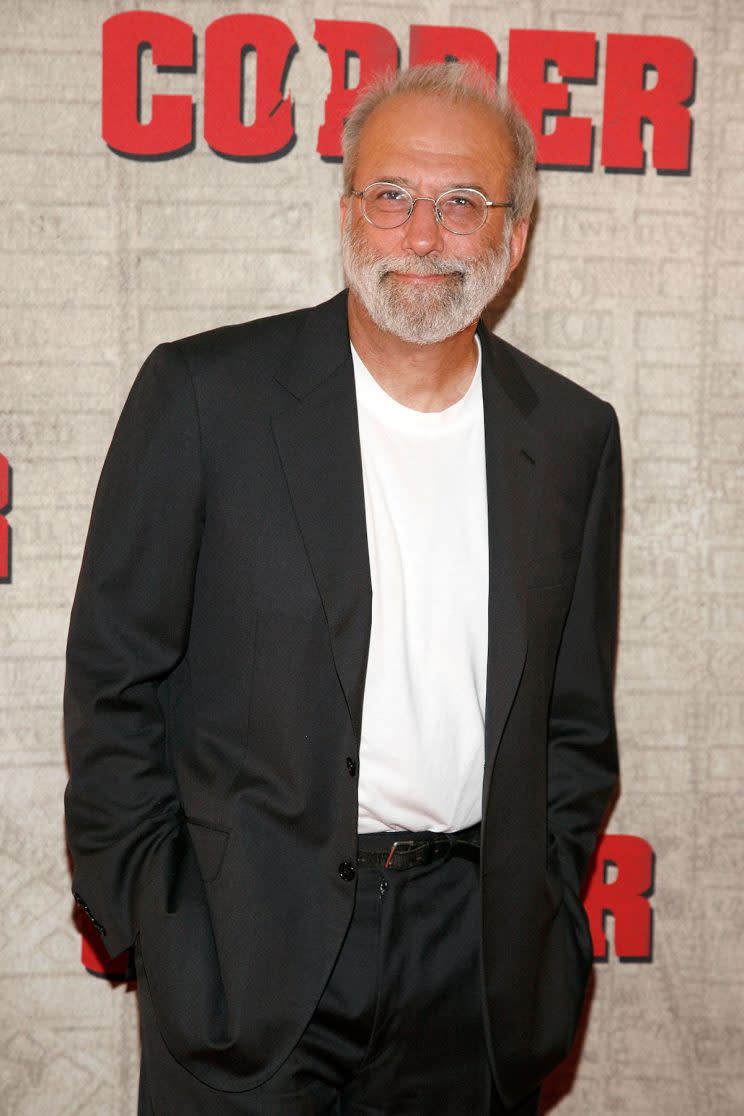
Chapter 1: The Wonderful Wizards of Oz
Tom Fontana never set out to be a premium cable pioneer. The Buffalo-born writer was a creature of network television, getting his start as a writer and producer on the beloved NBC medical drama St. Elsewhere before collaborating with Barry Levinson and Paul Attanasio on NBC’s acclaimed police series Homicide: Life on the Street. It was during the making of Homicide that Fontana found himself contemplating what happens to criminals after they entered the penal system. That germ of an idea eventually grew into Oz, which he developed in collaboration with Levinson. As Fontana quickly discovered, his show never stood a chance at making it onto a broadcast network.
Tom Fontana: I grew up watching cop shows where at end of the episode the bad guy traditionally got arrested and went to prison while the cops sat around in the last scene and did a funny little joke. Then we all went to bed feeling [satisfied]. While I was doing Homicide — where the bad guy didn’t always get arrested — I thought, "Maybe the more interesting story is what happens to these people when they go to prison." In David Simon’s nonfiction book [that inspired Homicide] there’s a section about a prison riot in Baltimore, and I decided to expand on it for an episode, [Season 5’s "Prison Riot"] and bring back some of the murderers we had seen in previous seasons. That was my first swing at seeing what writing a prison show might be like.
While developing Oz, I spent about two years going to prisons all over the country, and I saw that there were two kinds — these old Gothic horror chambers, and new, experimental prisons. But there was never a place where the two were together, and it was important to me that you had the old and the new butting up against each other. When I talked to prisoners who were in places like Emerald City, they were very clear that it was worse for them because they had no privacy. I found that very moving, and so that’s where Emerald City came from, and the idea of glass so that everybody could see everybody else at any given moment.
Back then there were only four networks, and none of them were the least bit interested in my version of a prison show. I sort of pathetically adapted it as I got each rejection. I can’t remember which network I pitched which version to, but one of them was set in a juvenile detention center, and another was a Club Fed, where it was rich white-collar guys who been sent up the river. Once I really started to examine what I wanted to do, I went back to the idea of that Homicide episode, which was a down-and-dirty prison with all sorts of crazy characters.
I was lucky that Chris Albrecht at HBO was looking to start doing original material. At that time, HBO had a comedy side — they had Dream On and a few other comedy shows — but they hadn’t really had a drama side yet. Chris had the vision to say, “We need to expand the reach of our network.” He told me that the [network] had had success with prison documentaries, so he had an instinct that a prison show might appeal to his subscribers. He said, "I’ll give you a little bit of money to shoot a presentation, about 15 to 20 minutes, and let’s see what it looks like."
Chris Albrecht: The show had been in development for quite a while before we were really even contemplating doing a lot of original programming. There was a change in management, and we wanted to ramp up our originals. We hadn’t ever done an hourlong drama before. I went to Tom and said, "Look, we’ve put you and Barry [Levinson] through the ringer here. I’m not going to ask you to make any more changes, but we need to shoot something, so here’s a million dollars. Shoot as much of this as you can."
Fontana: I probably shouldn’t say this, but I will — it wasn’t enough money! We shot it in Baltimore while we were shooting Homicide, so we would book a location and I would say, "OK, we’ll shoot the Homicide scene here, and then we’ll shoot the Oz scene." So, in a way, NBC paid for it a little bit, if you know what I’m saying.
Darnell Martin: I had directed a feature [1994’s I Like It Like That], but Homicide was my first television experience. They gave me the script for "Sniper: Part 2," and it was written like a film, with helicopter shots and blockaded streets. I kept trying to figure out how to do that for the budget and time that we had. Maybe that was a seller for Tom. He asked me to direct the Oz presentation.
Fontana: The cast of [the presentation] was different. Jon Seda and Terry Kinney were in it, but the part that Lauren Velez [now Luna Lauren Velez] played, Dr. Gloria Nathan, was played by Jennifer Grey. The reason I later made the change was I really felt like the cast was [too] white, and I also liked the idea of a Latina woman in the midst of all these men. And there was a different guy playing Augustus Hill than Harold Perrineau.
Martin: I cast Mos Def [now Yasiin Bey] as Augustus. He was amazing. Amazing. He was recast. It was crazy! I begged and I fought — not with Tom. It was above Tom; Tom couldn’t change it. Harold is wonderful, but you know, Mos Def had something really special.
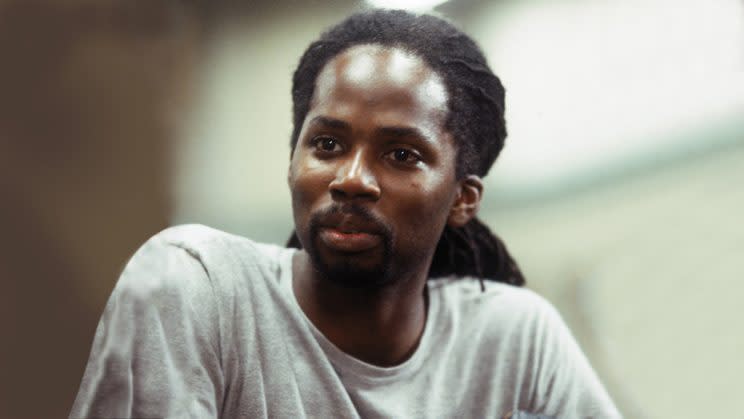
Terry Kinney: Tom had cast me in a Homicide episode [Season 4’s "Map of the Heart"], and he said that he’d always wanted to make up for that, because it was an indecipherable episode. I played an NSA mapping guy, and to this day don’t know what it was about! I remember meeting Tom and Darnell for the Oz presentation, and they were talking about a character that was a die-hard liberal in a way that seemed extremely naïve. I basically played the warden, whose name was still McManus.
Jon Seda: I worked with Darnell on I Like It Like That, and she raised the bar for me. I told her that anything she ever does, I’m going to say yes to it. Sure enough, they said, "Hey, listen, there’s a script that’s called Oz. It’s a presentation. Darnell Martin’s directing." I said, "OK, I’ll do it." I didn’t even know what the role was. What a lot of people don’t know is that at the same time that I was shooting that, I was also shooting the movie Selena. So when I met with Darnell, I said, "You’re going to have to help me, because I’ve been living as this sweet guy Chris Pérez for a couple months already, and now I have to play this ruthless Dino Ortolani." I didn’t know how I could do it, but she said, "Just trust me. Put everything in my hands and it’s going to be great."
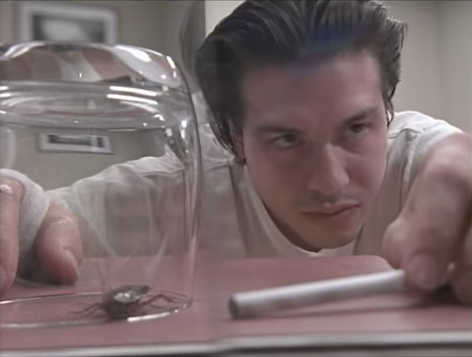
Tim McAdams: I had built a pretty strong relationship with Pat Moran, who was the local casting agent for Homicide. When they decided to do the presentation for Oz, I auditioned and got cast. Nobody knew what Oz was or really thought anything of it; I just knew it was a show I got hired for and I was a young actor trying to work. We shot this presentation, and Mos Def and Jennifer Grey were in it, so I was like, "Wow! We got some names in this thing, and maybe it’s gonna get some traction!"
I was honored to work with Jennifer Grey; I remember how excited I was and how friendly she was. And growing up in that era, having a chance to spend time around Mos Def and watch him transition to becoming an actor was really exciting. Sometime later I got a phone call about the show being picked up by HBO, and they said, "They’re gonna be doing a lot of recasting, but they’re going to allow you to play Johnny Post."
Fontana: That initial presentation was more tonal; it was a real attempt to say, "This is the kind of subject matter we’re going to cover, and these are the kinds of characters we’re going to see." You have to remember, this was before we built the Emerald City set, so it was all hallways and rooms, but it wasn’t what the show eventually looked like. Though, if you watch the first episode of Oz, there are a couple scenes that are from the original presentation, like the shower scene where Seda gets the s*** beat out of him by the COs. And I think the hospital scenes are from the original presentation.

Kinney: Jon Seda and I were two of the survivors of that 15-minute presentation. I didn’t think that I was going to make it to the series. I remember that I was in Los Angeles doing something else, and I called Tom and he said, "You know what, you’re my guy. Let me work this out." What I think they’d done is they wanted the warden to be African American. They wanted Ernie [Hudson], and they had a relationship with him. So Tom made me the keeper of the Emerald City section of the prison. I was grateful [for] his loyalty.
Albrecht: At the end of the presentation, the lead guy, Dino, gets killed in his cell. I said to Tom, "He comes back next episode, right?" And they said, "No, he’s dead." I go, "What do you mean, he’s dead? He’s the lead in the show!" They go, "That’s what’s happening here." That’s when I realized that they were gonna change the rules.
Seda: What’s funny is that I remember that the death scene wasn’t supposed to carry over [to the pilot]. I was expected to come on and be a regular on the show. I think what happened was that HBO just really loved the idea of the lead guy actually dying. That kind of set off the trend on Oz.
Fontana: We got an eight-episode order. I was literally yelled at by friends of mine and peers of mine on the drama side of television. They said to me, "Why are you going to work over at HBO? It’s a movie channel. Nobody watches it." And I said, "Well, who cares if nobody watches it? They’re going to let me make the show I want to make." Literally people thought it would kill my career, that I made the wrong tactical move and that I should be doing Touched by an Angel! I’d like to tell you that I’m the visionary who had this incredible sense that cable would someday dominate the television world, but it wasn’t that. It was simply that there was an open door and I went through it.
Chapter 2: Populating Emerald City
Having walked through that open door, Fontana’s next task was assembling his prison population. At the time, and still today, Oz stands as a model of diverse casting; its large ensemble encompasses a multitude of races, religions, and sexual orientations. And shooting in New York, Fontana tapped into a deep reservoir of veteran actors and fresh faces.
Fontana: Our feeling about the penal system in America is very cyclical; you go through periods of "[Prison] should be about redemption" and then "[Prison] should be about retribution." At that time, it was about retribution and there was this sense that prisoners were bad people, and there were no heroes in those stories. The truth is, I wasn’t interested in writing heroes per se. And that was the great thing about Chris. I’ve often quoted him as saying, "I don’t care if the characters are likable as long as they’re interesting." That was what I needed to hear because I wasn’t planning to make likable characters — I was planning to make interesting characters.
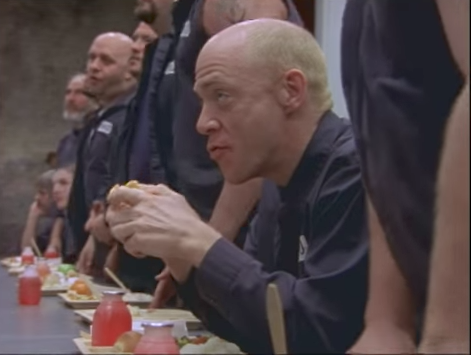
Throughout the life of the series, we were able to get some wonderful, brilliant New York theater actors. We’d used J.K. Simmons in an episode of Homicide, so I gave him the part of Vern Schillinger because I knew he could do it. Dean Winters had done Homicide episodes, and was my favorite bartender before that, so I wrote Ryan O’Reily specifically for him.
Dean Winters: Tom had come up with the idea of Ryan O’Reily by watching me bartend. When I was a bartender, I was a real hustler. My motto was, "If you leave my bar with cab fare, then I failed." I would try and drain you of every dollar you had. I quit my bartending job and was in Los Angeles doing my first movie, Conspiracy Theory. It was a real leap of faith. Tom came out to visit, and we had a long talk. I told him, "You know, I really don’t think this acting thing is for me, it doesn’t feel right." And he goes, "Listen: I was doing a little presentation for HBO about a prison, and I think it might turn out well for all of us."

Ernie Hudson: The first time I heard of Oz was when I got a call from Tom. I did a six-episode arc on St. Elsewhere [in 1984], where Tom was a writer and producer. I got to know him a little bit on set, and when he called me about Oz he said, "Do you remember we talked about working together on a project?" I didn’t remember that conversation, but I pretended that I did. I based Leo loosely on Robert Matthews, the first black warden of Leavenworth prison in Kansas. I read a book where he talked about how his father was a minister and wanted him to go into the ministry. Later on, he said to his father, "This is my ministry." I thought of it that way. He was a guy who finished college, but probably started at junior college and went to night school. He’s worked his way up. He’s the guy who loaned money to the friend and never got paid back.
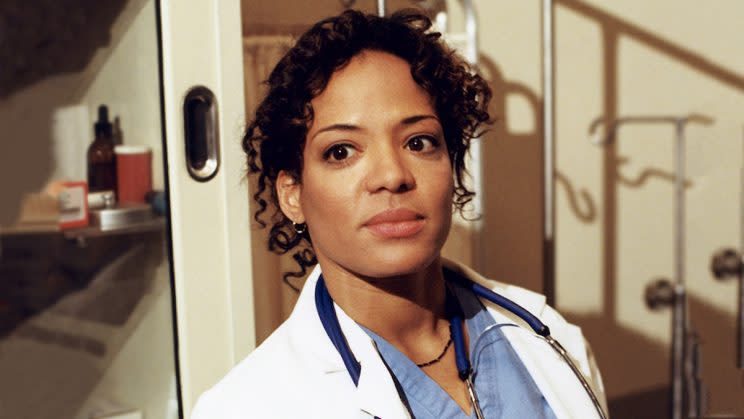
Luna Lauren Velez: My first film was I Like It Like That, directed by Darnell Martin. She called me and said, "Do you want to do this show, Oz?" And I said, "Well, I’m doing this other show, [the Fox drama New York Undercover]." She said, "It might be a one-off, I’m not even sure what’s going to happen with the character," and then she said, "Jon Seda is doing it." Jon and I had done I Like It Like That together, so I came onboard and they just kept asking me to come back. My understanding was that Jennifer Grey played Dr. Nathan in the [presentation]; everyone had glowing things to say about her, but said, “We decided to go a different direction.”
Adewale Akinnuoye-Agbaje: I went in and read for the casting director [Alexa L. Fogel]; there were only two lines and I read them in a British accent, an American accent, an African accent, and a Jamaican accent just to show what I could do with it. She told me to wait, auditioned a few other people and then closed up shop and took me over to Tom’s office. He was in the middle of writing, and she told me, "OK, he’s going to give you two minutes." He didn’t even look up; I performed the lines in those various accents, and he said, "All right, stop. That’s enough." That was it! He didn’t say I got the part — he didn’t say anything.
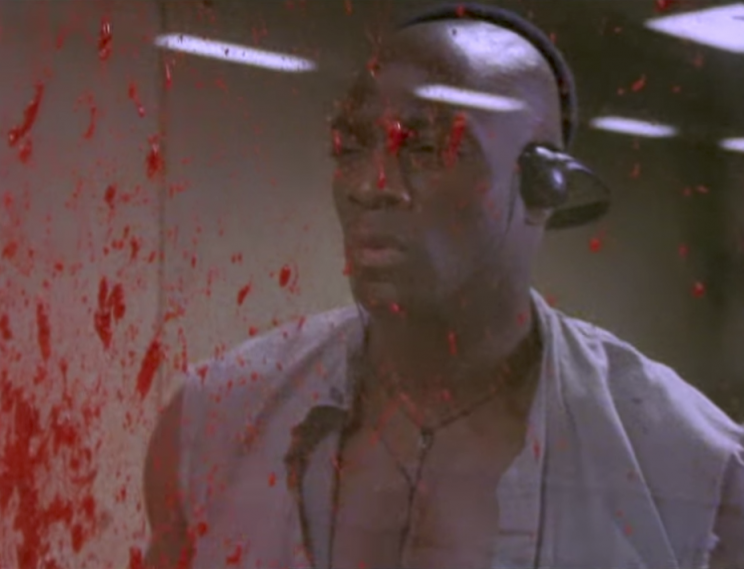
Alexa called me the next day and said, "Tom liked the African character, the Nigerian one. He doesn’t have one of those in the show, and he’d like you to play that." I was a little bummed, because I wanted to play an American. Then she said, "What he wants to do is he’s going to write it as an American and he wants you to be able to translate it into the African character," which was freaking great. When I met Tom again, he told me that he had a Nigerian friend he went to college with whose name was Bisi. So he said he would use part of my name and part of his friend’s name: that’s how Adebisi was born.
Fontana: Eamonn Walker was someone I didn’t know until he came into audition, but he was so incredible that it was a foregone conclusion he’d be part of the cast. I was obsessed with getting that character of Kareem Said right. And Eamonn was equally obsessive about getting it right. Some of the extras in his Muslim Brotherhood prisoner group were actual Muslims, so he would go once a week to the mosque, and pray and experience the whole religious side of what it is to be an Imam.

Kirk Acevedo: Originally Tom wrote Miguel Alvarez for someone else, and then I came in and I got the gig. I remember the exact audition: There were five actors ahead of me, and the scene was an emotional scene where you had to go in and scream and yell about some s***. Every actor who went in before me screamed and yelled, and I was like, "Well, I can’t scream and yell, because no matter how good I can do it you’re gonna get tired of seeing the same f***ing thing." So I played it just the total opposite, and I stood out and got the gig.
Lee Tergesen: I had been doing a show for USA called Weird Science, which had just finished up, and I was working on Homicide for a couple of episodes. I was down in Baltimore and Tom said, "When you’re done, can you come up to New York? I want to talk to you about something that I have in the works." So I went up and he and I started talking about something that ended up being Oz. We talked about a couple of different ideas he had for parts, one being a guard and the other one being this guy who ends up being in jail as sort of a fish out of water. I was like, "That sounds more interesting than a guard."
Fontana: Initially HBO didn’t want me to cast Lee as Beecher. I was like, "Well, what’s wrong with him?" And they go, "Oh no, he’s a brilliant actor. It’s just not who we had in our head." I said, "Well, he’s who I had in my head, because I wrote the part for him. So you’re stuck with him." And then, of course, they were [ultimately] thrilled with him. But at first they were a little nervous, because he didn’t look like who they thought Beecher should look like. I never understood what that meant.
Albrecht: I do remember talking about that, because Lee was such a prominent character in the beginning. We were kind of new to it all. I had worked pretty closely with Garry Shandling on The Larry Sanders Show and Marta Kaufman and David Crane on Dream On, but this was really the first time that we had this size of a show, and this kind of serialized drama. So I think we were just babbling at Tom and Barry, who obviously had a lot more television experience than we did.
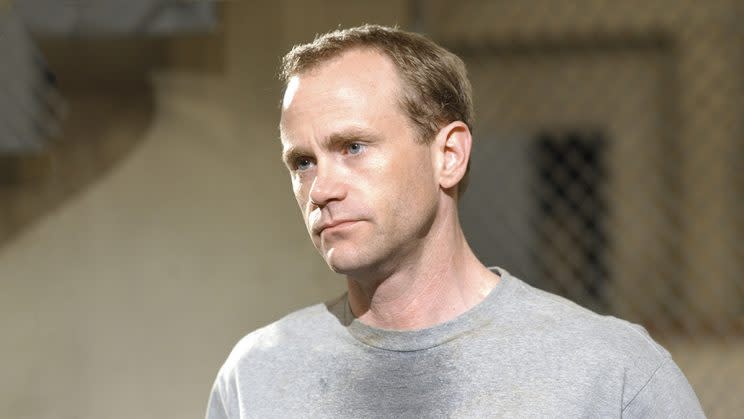
Tergesen: In retrospect, I know that happened, but Tom didn’t make me aware of it at all in the beginning. But yeah, my understanding now is they [thought]: "This character is so important, and this guy has just being doing Weird Science." And Tom was like, "Well, don’t worry — you’ll see, you’ll see." I wonder what they think now!
Fontana: I had met Rita Moreno at a party at Elaine’s that was marking the end of The Cosby Mysteries, which she had been a regular on. I went up to her and said, "It’s such an honor to meet you — I’m such a big fan of your work." And she went, "Well, if you’re such a big f***ing fan of my work, why didn’t you f***ing write me a part?" I went, "OK, I will!" So years later, I took her and her husband to dinner and was talking about Oz. She goes, "It all sounds fantastic. What would I play?" And I went: "You would play the nun." Well, she laughed for about a half hour and then said, "Tom, I’ve played hookers, I’ve played bandits, but no one’s ever had the balls to ask me to be a nun." I also talked to her about my sister, who is from a very liberal order of nuns. In the summers, she would run the hospitality house at a prison near Buffalo. I always thought it was so incredibly ironic that my sweet sister was scheduling conjugal visits for prisoners. I told Rita all that, and she said, "OK, just as long as I’m not going to be in one of those habits."
Martin: Tom was fabulous in the way that I could say, "Tom, check this guy out. Is there a place for him?" And he’d say, "Yes, I’m going to write him into it." There were some people that were just out there in the world, and not necessarily actors yet. He was really open to bringing people in, looking at them and trying to find the place for people who had this very specific New York vibe. With a network, you try to get someone hired and it takes so long. With HBO, it was fabulous: if Tom and I liked an actor, we would go to the one person over there and it turned around real quick.
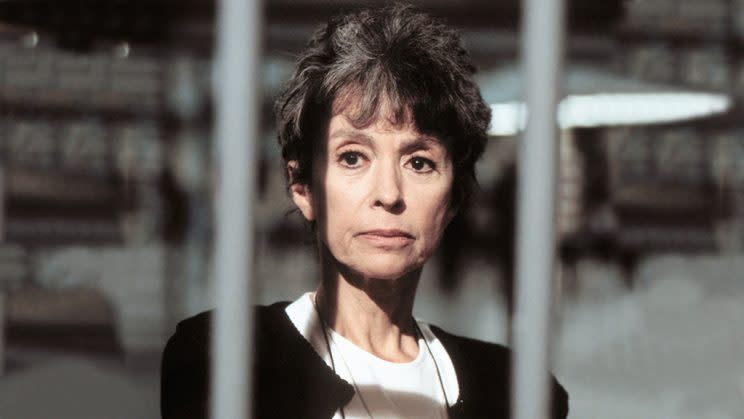
Fontana: I was very clear in the auditions, and when people signed the contract that they might be asked to be nude, and that there would be violence. I didn’t want people who were going to be skittish.
Akinnuoye-Agbaje: Tom made it clear that this was going to be groundbreaking, and that he was really targeting authenticity, so that meant that it required certain actors and certain characters to go in places that may be uncomfortable personally. There were rape scenes and all kinds of complications that weren’t going to be comfortable. He made it clear that if you don’t want to do that, then you’re not the actor for the part.
Acevedo: No, he never warned us! I think there was a nudity waiver because there might be nudity. But every week it was like, "Alright, Kirk, today you’re gonna eat s*** out of the toilet." Every week we were just like, "Dude, as long as I don’t get raped, I’m alright." It wasn’t a scary thing, it was kind of titillating. It wasn’t like we were all nervous about it, because we would do it. It was more of like, "What’s he gonna have us do?" I don’t ever remember him warning me, but then I’m pretty sure there were people he didn’t have to warn because we were all game to do it.

Winters: I was there from the inception of the show, and I told Tom, "Look, I’ll do anything you want." And I did. The smart actors knew that we were doing a show about a prison, not a show about a prep school, and it’s cable television. If you had half a brain you knew that this was not going to be everyone’s cup of tea, and it was not going to be a walk through the daisies. So that’s the way that I approached it, and obviously there were people who had a hard time with it. Some guys didn’t want to do this, some guys didn’t want to do that, but that’s the nature of the beast, I guess.
Kinney: I remember in the first episode that Edie Falco [who played a correctional officer] and I were supposed to have a love scene during an execution. As someone was being electrocuted, we were supposed to be having sex in a cell. As much as everybody took their clothes off on the show, both Edie and I felt it wasn’t the right choice, and asked if we could do it in a way that was less graphic. From that point on, that’s how my character was treated. I wasn’t one of the people who had to do [anything graphic].

Fontana: I have to say, over the course of the series, there was only really one actor who lied to me and said he would do whatever I asked him, and then when it came time he said, "No, I’m not going to do it." But he wasn’t a regular and I was able to kill him off fairly quick. Let them guess who that was!
Chapter 3: Getting Into ‘The Routine’
Some TV shows take a little while to find themselves, but Oz‘s series premiere lays down the law about what viewers could expect from their time inside Emerald City. Written by Tom Fontana and directed by Darnell Martin, "The Routine," swiftly establishes all the elements Oz would become infamous for, including densely intertwined narratives, a parade of compelling characters, shocking acts of violence and a pervasive sense that nobody is safe within Oswald’s walls. Especially not the person you think is the main character…
Fontana: In terms of the writing of the first episode, Augustus was the first voice I heard in my head. In terms of the design of the show, Beecher was the first character that I came up with, and then McManus. One is there as a prisoner, and one is there as a warden. It just seemed like, for the audience, Beecher’s our Dante coming into the Inferno. He’s the one who’s guiding us into this world where we’re going to be exposed to these different cycles of violence.
Jean de Segonzac: The very first scene we did was in McManus’s office where he tries to put the glass on top of the cockroach. That was the very first shot on the very first day.

Kinney: I hated that scene. It was a trained cockroach; there was a cockroach handler, and backup cockroaches. That’s a delicate area for me, cockroaches. We did endless angles on it, because Darnell did a lot of angles.
Winters: I knew no one on my first day besides Lee Tergesen. So it was like the first day of school at a juvenile delinquent reformatory. Everyone’s kind of looking around going, "Oh yeah, so you’re Alvarez, alright. I got to keep my eye on you." Or "You’re Adebisi, alright, you’re big and scary, OK." Or "You’re playing Said; OK, you’re kind of cool, but what’s up with the English accent?" In the first couple of days, it was just like, "What the f*** have I gotten myself in to here?" But in a good way, obviously.
Tergesen: Nobody really talked to me in the beginning. In the first four or five episodes, the extras would not talk to me. But once Beecher went crazy and attacked Schillinger [Episode 7, "Plan B"], all of a sudden everybody was like, "Hey Beecher, Beecher, Beecher, oh hey Beech!" It was so weird. It was like high school.
Fontana: This is a little piece of backstage history: We shot the pilot and the first season in Manhattan at what is now Chelsea Market, and what used to be the old Oreo cookie factory. The cafeteria had really high ceilings because the stoves had to go up to those windows to let out the smoke from baking the Oreos. We always had to cut if somebody left the cafeteria, because there was no way they could walk to the next set. It was all a bunch of different rooms.
McAdams: I’ll never forget the first time I arrived on set. You’d get off the elevator, and it would be like a normal office with people going about their duties. Then you’d turn the corner, walk down a little bit and you’re in prison.
Akinnuoye-Agbaje: We were about five floors up; the first four floors were offices, and then when you got to the fifth floor, it was literally Emerald City. At any given time, there were 300 or 400 extras in there. The cells were real cells, with the right size and proximity. It was hot, sticky, and you felt claustrophobic, like you were in prison. In between takes, there were waiting room areas where we could go, but I chose to stay in my cell for the whole time.
Seda: It was scary when the reality hit you that this is the life for so many; at least we were actors and able to walk away at the end of the day. All the details were incredible, and it just really added to making it just so authentic. The set itself was probably the biggest character of the show.
Hudson: It was like being transported to another world. I’d walk to work from the Upper West Side down to where we were shooting, and the contrast of being on the streets of New York and then going in and being on the set of Oz was cool.
Winters: People used to ask: "How did you prepare for the role?" It was very easy. You just got off the elevator, and walked down to the set. It was a f***ing prison! With the glass cells, you realized that everyone was being watched all day long. It was very unnerving. I remember Vincent Gallo came by the set one day, and he was looking around and goes, "Man, this set’s the f***ing cream." Meaning, they really nailed that set. And my brother [Scott William Winters, who joined the cast in Season 2 as O’Reily’s brother, Cyril] actually spent the weekend on the set by himself, just to get that feeling of incarceration.
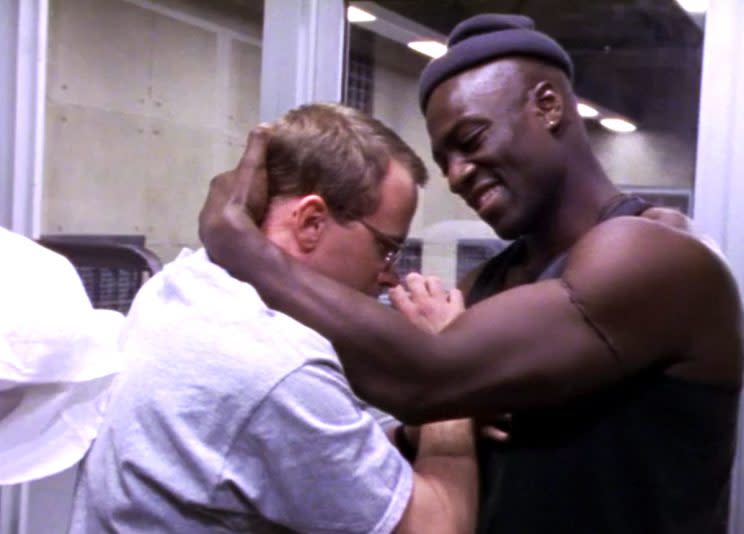
Akinnuoye-Agbaje: For my scene with Beecher in the first episode, Lee and I were meeting for the first time as actors. It was kind of organic because his character was entering the prison, and it was a new world for him, whereas I’m a lifer. The thing for me was to establish that I own him. I own his life, I own his physical body; he was going to be my bitch and do exactly what I told him to do. I had the luxury of sleeping in my cell, and I would not wash. I became one with my own odor to stake my territory [despite] the complaints of the DP and the crew. Quite often they said, "Perhaps you should shower." But I told them I was going to stake my claim. Whatever feeling I would evoke in the crew was exactly the feelings that were intended when the actors would come in my cell: repulsion, fear, and disgust. It was lovely!
Tergesen: I don’t remember that! I do remember Adewale being ridiculous. He was so f***ing good in that part. I used to say that being in that cell with Adebisi was like being on a date from hell that lasted a month. I mean, he literally grabbed my penis more than women I had dated for a month.
Akinnuoye-Agbaje: I had two scenes in the first episode, and was meant to die in the second episode. But Tom liked what he saw [in the premiere], and kept liking what he saw. I’ve lived a life that gave me an insight as to what it was like to be in a gang in my teenage years, so I just brought that rawness to it. I wore my hat in the way that I used to wear when I was a teenager on the street myself. I knew that the tilt of the hat represented defiance. The costume and production were very much against me wearing the hat initially, because they wanted everybody in prison to be uniformed. I had to respect that, but I just knew that I needed to put my stamp on the character. That scene with Beecher was the first scene I shot, and when they said "Action," I pulled the hat out of my pocket and put it on. When we wrapped and moved onto my next scene, the director said, "Wait a minute — he had the hat on. Now we have to keep it."
Tergesen: I was so happy to get out of [Adebisi’s cell], but then I go to Schillinger’s cell. We didn’t rehearse at all on that show, so J.K. and I just met when we started shooting. The funny thing about him is when we’re playing those initial scenes, it’s like he’s the nicest guy on the planet. You know, he’s always smiling. It’s like, "I can trust this guy!" And then it just devolves. The branding thing ends up looking like I’m getting f***ed in the ass, which I didn’t realize was going to happen. Not that I minded, but when he was burning my ass it was causing me to like buck like I was getting f***ed. That was my ass, bro! No stunt ass.
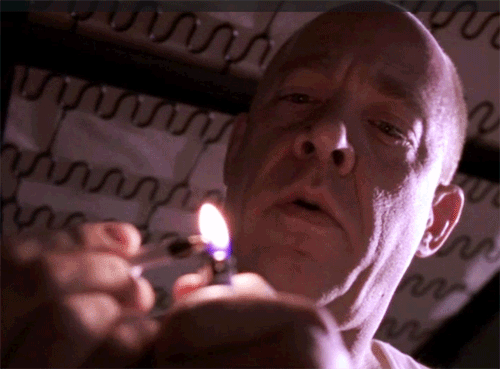
De Segonzac: One image I have, which I can’t get out of my head, is Tergesen’s ass two inches from my face while Simmons is branding him. I’m just going, "This is the weirdest way of making a living that I can ever think of."
Fontana: When it came to shooting the first episode, moments like the swastika on the ass were defining moments for the show. And the moment when Dino is naked and getting beat up in the shower was, at the time, as brutal a scene I’d ever seen on television. Those are, to me the moments that said to people, "This isn’t your father’s TV show."
Seda: The shower scene was wild. It showed how quick things can happen in prison. Dino wasn’t afraid of anyone, and I was so into being that guy that I carried that with me. I literally walked onto set butt-naked. I walked right up, and stood there talking to Darnell as if I had clothes on. I said, "OK, let’s go. Let’s shoot this scene. What do you want me to do? You want me to do this? Want me to be here? Want me to do this? OK. Great, let’s do it."
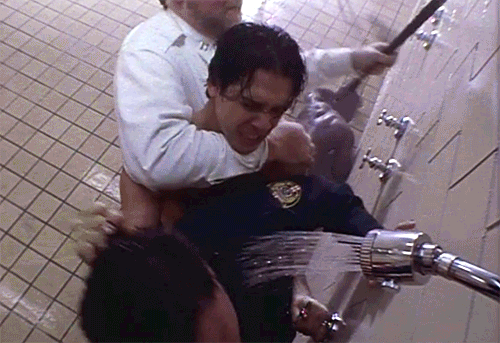
Velez: The storyline with Dino and Emilio [a prisoner dying of AIDS] really resonated with me because I have friends and a family member who are HIV positive. I also loved working with Jon. There’s one scene where I could barely keep a straight face because we had done that movie together, so there was something delicious about watching him play this wise-ass character. It’s really one of the few times in the pilot that you see Gloria engaging with one of the inmates in a fun, slightly flirtatious way.
Seda: Jose Soto did such a fabulous job as Emilio. What I love about that scene was how well it was written. It wasn’t that Dino just didn’t like Emilio because he had AIDS; Dino actually found compassion for him. The fact that he honored his request to take him out was done from compassion. That was a way for Dino to be in touch with his heart. It was just brilliant.
Fontana: When I talked with Chris Albrecht, he said, "What’s the one thing you’re absolutely not allowed to do on a broadcast television?" And I said, "Kill the lead in the pilot." And he said, "Well, then go ahead and do it." So I hired Jon and told him this is what’s going to happen. He was cool with it, and then I hired him on Homicide, to sort of compensate for the fact that he was killed off.
Seda: For Dino, there’s a point where what was keeping him afloat was the fact that he still has his family out there. There’s a scene where his wife comes to visit him and the kids are there playing and that’s when he makes the decision that it’s never going to happen. The reality of the fact that he’s here for life really hits him. Darnell and I added a moment where Dino taps the glass, kind of like he’s touching her for the last time as a family. I don’t know if a lot of people realize or catch it, but that tap on the glass to her is basically saying that’s the last time she’s ever going to see him. From that point on, it’s just a matter of time for Dino.

Winters: I remember reading the script and going, "Oh, Dino’s a badass!" And by the way, Tom named the character after me, because my nickname is Dino. Then all of a sudden he’s dead, and I’m the one who has him lit on fire. My first thought was, "I feel pretty f***ing good, because I’m not the one dying!" But I was also blown away that this was what Tom was going to do.
McAdams: To say I was excited [to kill Dino] would be an understatement. At that point, I didn’t realize that I would be the first inmate to kill somebody on Oz. That didn’t connect until way later, what I realized the show had a reputation for killing people off. The idea that I was going to be killing someone was just a thrill, and I knew that it was going to be memorable. The fact that they were killing Jon off in the first episode told me how edgy the show was going to be. No one’s safe, and episode to episode, you don’t know what’s going to happen, who’s going to die, and how it’s going to happen. You just don’t know. You have to tune in and watch.
Seda: Talk about going out in a blaze of glory, right? That’s what he did. It was pretty wild how it was shot. I remember seeing the dummy that they had made up in the makeup trailer, and I said, "Oh my gosh, that dummy looks just like me!" When we were shooting it, I remember just looking up and telling Tim, "Hey, hey, hey, don’t actually light it." A couple times, he kept forgetting and actually lit it. I’m like, "Wait! You’re going to drop this on my face, dummy!"
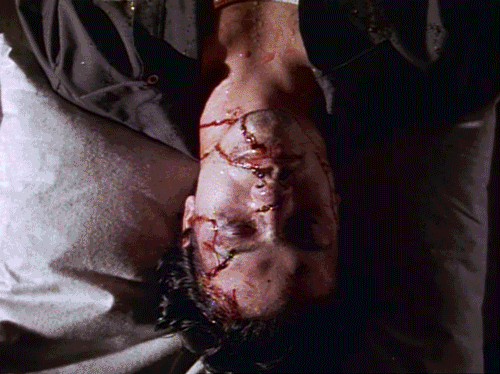
McAdams: Dropping that match under the camera and watching those flames come up was the most exciting and invigorating feeling. To this day when I see it, I still get excited. Because that wasn’t CGI, it was a glass plate. Also, being given the creative autonomy again to just go in there and have fun with it. Johnny Post wasn’t wired right, so just dropping the match would’ve been one thing. But dropping the match like, "Boom, you’re gone," was so fun as an actor, because we were so deep in the character at that point.
Fontana: I wanted to do a show in which the audience never relaxed, because these men who are in prison don’t get a chance to relax. So if I’m really going to try to convey what they’re going through, then the audience should never be able to kick back.
Winters: I’ve never seen this before or since: The scripts would come out, and people would take one and rush to their dressing room, a corner of the set or go in a jail cell, and read the script and see if they’re still alive at the end. It was nerve-wracking.
Seda: I don’t remember any [farewell] party. I think it was just, "All right, you’re dead. Goodbye." But Fontana came to me and said, "Don’t worry. I’m going to bring you on Homicide." So that worked out great! [Seda played Detective Paul Falsone on the final two seasons of Homicide.]
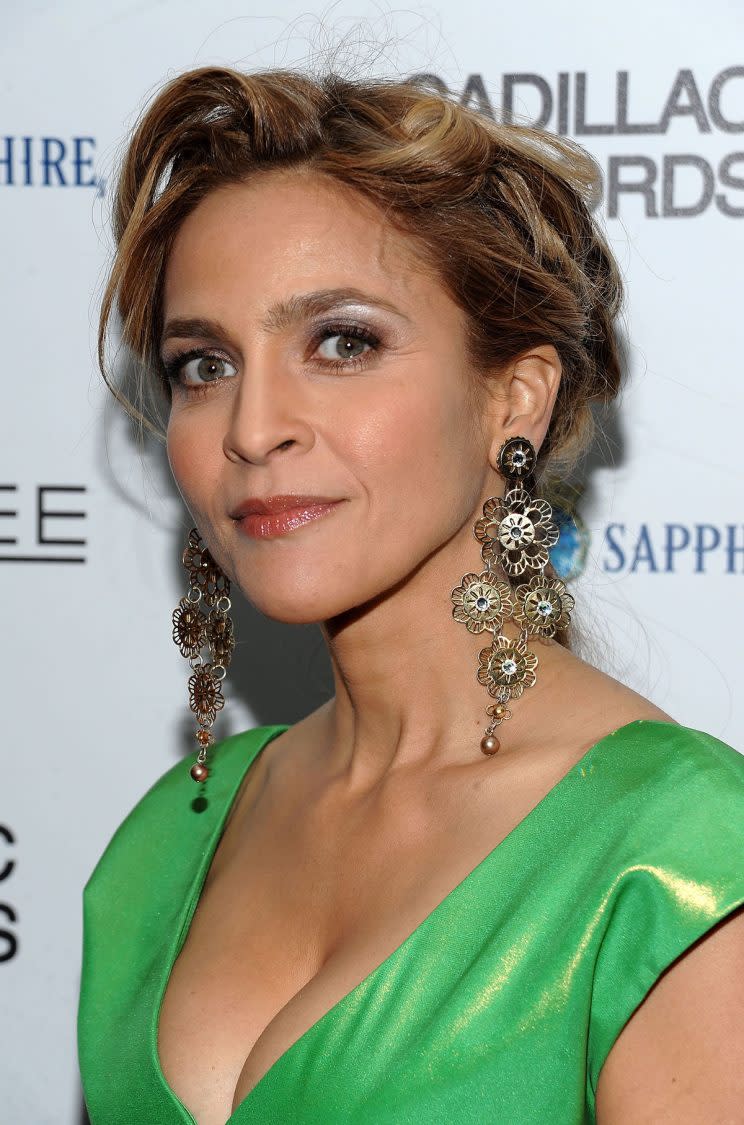
Chapter 4: The Future Was Female
When the histories of cable’s rise have been written, they tend to dwell on the accomplishments of male showrunners like David Chase, Alan Ball, and Shawn Ryan. While Tom Fontana is certainly part of that group, both he and Oz‘s cast are quick to note that one of the show’s key creative architects was a woman. As the director of the original pilot presentation, and then the series premiere, Darnell Martin established the innovative visual language that distinguished Oz from anything else on TV at that point. Having gotten her start as an independent filmmaker before landing television gigs, she sought to infuse the series with some of the same spontaneity and energy that defined that era of indie movies. Martin continues to alternate the occasional feature film, like 2008’s Cadillac Records, with a diverse slate of TV credits that includes such series as Grey’s Anatomy, Zoey's Extraordinary Playlist, and New Amsterdam.
Fontana: I’m not a director. I never aspired to be a director, and I have no real interest in it. So I rely very heavily on directors to create a visual style that goes with the storytelling, and I trust directors that I hire to bring their best game to the playing field. Darnell was there from the beginning. She and I had worked on Homicide together, and I thought, "Oh, she’s really got some stuff going on here." I suppose back then the idea of a woman directing a male prison show didn’t make sense to some people, but it made sense to me because of Darnell.
Martin: The funny thing is, I didn’t want to do it at first! I had brought another project to Tom, and we brought it to ABC and ABC ended up not making it. I really didn’t want to do this show. Not because I didn’t like it, it was just because I had a thing about people in jail. I grew up in a very rough place, and I know a lot of people that really needed to go to prison because the neighborhood was a lot safer with them not there. I had my own very real and personal reasons not to want to glorify that. Then I said, "Let me go visit some [prisoners]." So I visited prisons, and said, "You know what? People in jail are human beings, and there but the grace of God go I." I didn’t want to do it if they were going to be other than me. [But when I] saw people in prison and how they were living, that helped me emotionally get around dealing with the show and made me want to do it.
Albrecht: Darnell was such a critical part of setting the tone and the style; she worked with Tom on the production design and how to shoot this. I think we all set out to do something different visually. Drama has been a staple of network television obviously, and the fact that we [at HBO] were now entering that arena, the one thing that everybody felt was we really needed to differentiate ourselves. I don’t think any of us on the HBO side had any idea that Tom and Darnell were gonna take that so literally, and just make something that startlingly different.
Winters: Darnell Martin is no joke. She came in with a vision, and her vision just happened to match Tom’s. I think she’s kind of left out of the conversation a lot of times when it comes to Oz, and she should really be part of the conversation because she came in there as a woman, in a hyper-male environment, and she laid down the law in this jail. She really did; and people took notice.
De Segonzac: She’s someone with a real vision. Tom was always telling me, "Just do your thing." And I, of course, was trying to do Darnell’s thing. The [visual] theme was us being in these tight quarters, just participating. Basically, we just did whatever we felt like within the moment. As you’ll see, some scenes are all on a dolly and laid out, and others are completely handheld. For one shot, I remember being on a foot dolly, and going around the edge, while Jon Seda is trying to force feed a guy who’s dying of AIDS.
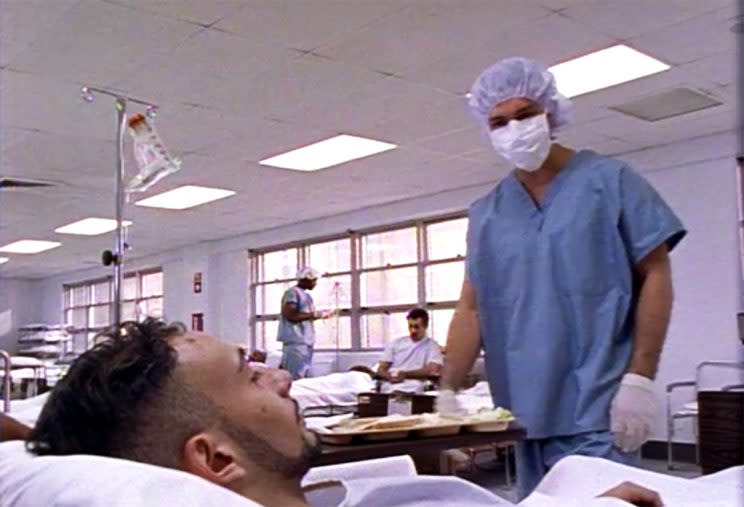
Martin: There’s an idea in television that I don’t think makes the best television, and that is you have a plan before you get there. If you’re new at doing this, that’s probably helpful. The bad thing about it is that you can have a plan, and then all of a sudden the light is over here so you have to deal with shadows or maybe an actor has to go to the hospital. There’s always some kind of issue in this business. What you need to do, and what I like to do, is go to a place, sit in that place and come up with all the ways I could shoot it. I think shot lists are so reductive, because you can go through every scene [ahead of time], but in reality, you didn’t even work with the actor. You have an idea of blocking, but it’s only you that knows exactly how you’re going to block it, and then you’re going to make that actor a puppet. That’s a big problem. These actors were very passionate about their characters, and had very strong ideas about their characters, and they all had their homework done when they came in. They were all willing to rehearse and find it, and they were generous to one another.
De Segonzac: We had to go fast, fast, fast because there was so much to do. I remember that the dolly guys would just be sitting on the dolly [between takes], and I was like, "What the f*** are you doing? There’s not sitting around here." At 7 a.m. all the cameras were built, the sound cart was ready and the actors were on set in costume. There was one time where we were running out of time, and Tom happened to be visiting the set. Normally, he wouldn’t be there, but he showed up and he was angry that we were going to go late. So I’m saying [to Darnell], "We’ve got to go fast, so if I do this and this, will you be happy?" And she was angry at me. Tom pulled me by the arm and said, "Why are you talking to her? Just do your thing. Just do whatever you always do." 15 minutes later the scene was done.
Kinney: Sometimes somebody would be late, and that was a bad thing, because we had to start at 7 a.m. and finish at 7 p.m. If somebody showed up for the first scene late, then that person had sole responsibility for killing our day. We all understood that. For the most part, there was never a hitch in any of it. Darnell had a very specific shooting style; it was a lot of pushing in. The camera was its own character. It was cool to be a part of, but at the same time, you had to hit marks a lot in terms of your acting with that style. You had to turn at exactly the moment the camera arrived. She did a lot of things as one-offs, and that saves some time, but it also makes for very complicated shots. We used to get into little dustups about it, but it wasn’t anything that was bad. I would just say, "I’m trying."

Tergesen: She was a very strong personality, but I got along with her pretty well. Every once in awhile there would be something camera-wise [that was tough]. I remember I had a scene with Terry Kinney, and I thought, "Why would I stand right here in a place where he can look at me?" And she’s not letting up or even letting me have an idea about what I wanted to do. She’s rolling the crane across the big main room, and I’m like, "Is this about a crane shot?" She said, "No," and of course it was about a crane shot. It was a cool shot! Sometimes you have to give up to the people who know what they’re doing.
Hudson: I like Darnell. I did not like the fact that she really liked Eamonn Walker more than me. That really annoyed the hell out of me. She kept praising him and didn’t have a damn thing to say to me. Since then I’ve gotten to know her. In fact I did a series called APB for Fox, and she directed one of the episodes. I really like her a lot.
Velez: I can put any episode on and say, "Darnell shot this." She’s got a great eye; it’s the specific way that she’ll shoot something. Or those unexpected, beautiful tracking shots that Darnell does. It’s almost like a dance with her, and theatrical as well, because it has to be seamless.
Akinnuoye-Agbaje: Darnell would do these sweeping moving shots where she would literally introduce about 10 characters at the same time. There was a lot of movement, and you just had to do all your dialogue on the move, and interacting with other characters. It was very fluid style, which was tricky because as an actor you just have to be very ready, and very much engaged in your character so that you don’t miss a beat. You had to be in rhythm with the flow of the camera because it moved a lot with Darnell. It was alive, and I think that’s what it was meant to capture.
De Segonzac: We shot everything on 16mm; there was never any question of going 35mm. Back then, the 35mm cameras were immensely huge, and very heavy. For the spaces we were crunching ourselves into, it never would have worked. We were just constantly doing stuff you could never do with a big camera or a huge dolly. At one point, I got enamored with the Dutch tilt [a canted camera angle], so I’d start my shot at a Dutch and then move back and straighten it out, or maybe even Dutch it the other way. I wanted to have fun. After a week of doing that, somebody tapped me on the shoulder and gave me a phone message from Tom, and it said, "Enough of the f***ing Dutch tilt."
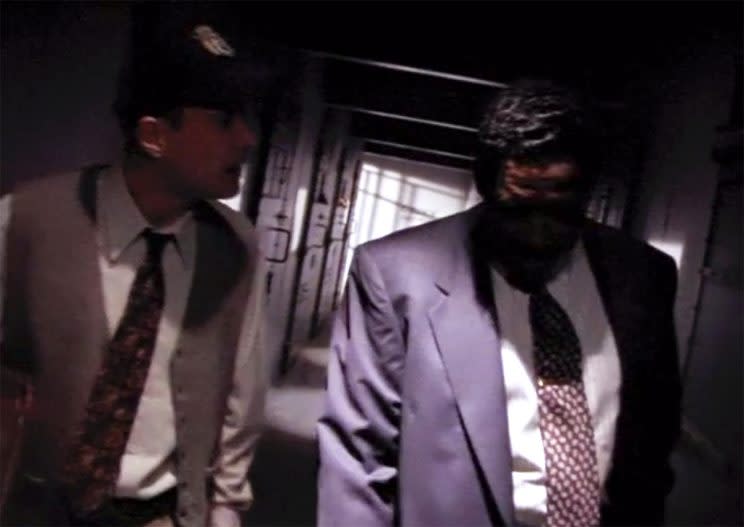
Fontana: The cube that Augustus is in was her idea. I kept saying to her, "We’ve got to find some place where he’s isolated, but I don’t want him to be in front of black curtains or something." She was at some museum, and there was some kind of cube there. She told me, "You’ve got to see it, because that’s what I think we should use for Augustus." Every director after her hated that cube! But I insisted that they had to use it in some way, shape, or form because it was so expensive to build that I wanted to amortize it over the course of the series.
Martin: I was at the Whitney Biennial, and I saw this box in a room that was tilted on its side. I wanted to utilize something like that, and I brought that to the production designer [Gary Weist] who was phenomenal. From there, we started to riff; we riffed about 2001: A Space Odyssey, the way they’re kind of under this glass. We started talking the tricks we could do with the box and really show this idea of isolation, and no longer having any privacy. You can’t even go to the bathroom without the world videotaping you and watching you.
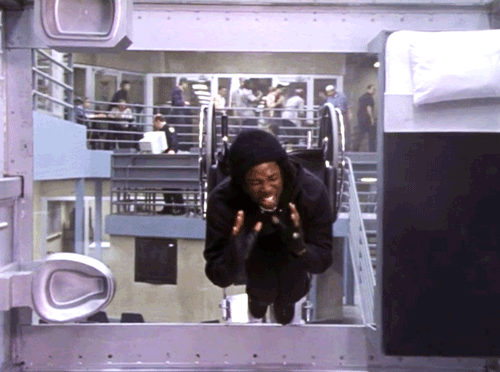
De Segonzac: I saw the same show at the Biennial. The box just looked like a silver box with windows; some kind of construction art. I was not impressed by this thing at all, and it didn’t occur to me to think twice about it. But she came while we were building the set, and she was talking all about this box that she saw. Perrineau’s character was supposed to be in a wheelchair, so he had to be able to get in so that his wheelchair would be latched down and the whole box would turn and move. We built a box that had a crank and a motor on it, and we could put Harold in there, strap him down, and send him upside down.
Seda: I got a chance to be in the box in one of the episodes where Dino comes back as a ghost [Season 6, "A Day in the Death"]. It was pretty wild. Harold had so much dialogue, and [I loved] the way he made it flow in that setting. I’m sure Harold would say he loved it because it made him become one with the character. That cube just became his M.O.
Tergesen: The crank made so much noise that you couldn’t shoot sound with it. So Harold had a lot of looping to do. I did a few things in the box, and, of course, J.K. and I did that Barry Manilow song, "The Last Duet" [Season 5, "Variety"]. That was a song I was gonna do in the 10th grade with my girlfriend, but we never did it. As soon as I thought of it [for the episode], I knew Tom was going to love it. And then two years ago, I was sitting next to one of the guys who wrote the lyrics for that song. He said, "You used one of my songs in your show." And I was like, "No s***. I picked it!"
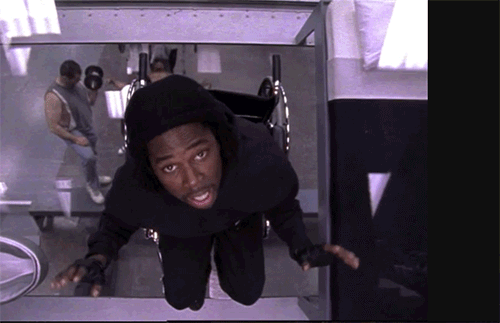
Kinney: I really liked the cube. In the two episodes I directed [Season 3, "Cruel and Unusual Punishments," and Season 4, "Wheel of Fortune"], I did some very fun stuff with it. In my first episode, I remember making Harold be in smaller and smaller boxes, until he was inside a little dark thing. I didn’t find it an entirely successful exercise; I would have needed production values that we just didn’t have at the time. For the second one, I made the cube a big lottery thing. We spun it around with all the balls inside. I strapped myself in and tested it out before I put Harold in there to see if he was going to be able to talk and hang upside down a lot. He was amazing, that guy. He’s an acting machine. Every time he gets to the cube, he’s not only super-prepared with those monologues, but ready to take on any challenge to get it done.
Fontana: Where I get nervous is when a director creates a visual style that isn’t telling the story, because then I think they’re just showing off. But if you have a director who stages a shot like that great shot that Darnell does in the first episode where we see Emerald City for the first time, and the camera moves wide? That to me is excellent visual storytelling.
Martin: What’s great about Tom is that he understands filmmakers; he’s not trying to prove anything, and he’s really open to being collaborative. The problem now is that that we’ve dumbed down the idea of directing episodic TV. On a lot of these shows, anybody can walk in and do it. Directors like working for Tom, because Tom doesn’t consider them idiots. He created these wonderful stories, he had a great vision, and then he put it in the hands of other artists who gently put it through themselves and added new colors to it. I think he set a tone because he was not a dictator or micromanager. No one knows I directed the premiere. It started with a female director, and that was only possible because it was a forward-thinking man who thought that was important.
Chapter 5: Life in the Big House
As Oz’s first season unfolded, the cast and crew became comfortable inside this prison of their own making. Largely left to their own devices by HBO, a familial atmosphere flourished on set that was nourished and encouraged by Warden Fontana. As with all families, tensions occasionally arose, but nothing like the prison riot that closes out the first season.
Fontana: What was important for me, and what I always worked very hard to do, was take a character who was despicable and turn him into a sympathetic person. And then, just when the audience was rooting for that person, have them do something despicable again. So if you watch the series over all the seasons, you’ll see character like O’Reily who do the worst possible thing and then have this incredible moment of vulnerability. And then as a reaction to that, he does something worse! The other thing I promised to myself was that every character in Emerald City belonged there. I didn’t want to do the wrongfully convicted story. Not that that isn’t valuable; it’s just that I met so many men in prison who told me they were innocent that it felt like almost like a joke. It would also feel more mainstream to suddenly have a character in there that was innocent.
Kinney: In the first episode, Darnell saw McManus as one of those misguided but well-intentioned educated white guys. He thinks everybody can be rehabilitated, and put back out onto the streets. But the prison system itself teaches you otherwise. Given that conundrum, this character was an anomaly in the prison. In the first episode, I was campaigning with Tom to change that. I said, "We’ve seen that guy, and he’s going to wear out. You’re going to lose interest. Let me change. Let the prison system seep into me. Let me become more and more one with it." Slowly but surely, Tom agreed to start shaving my head a little more, to grow the beard, and to start to look a little more like a prisoner.
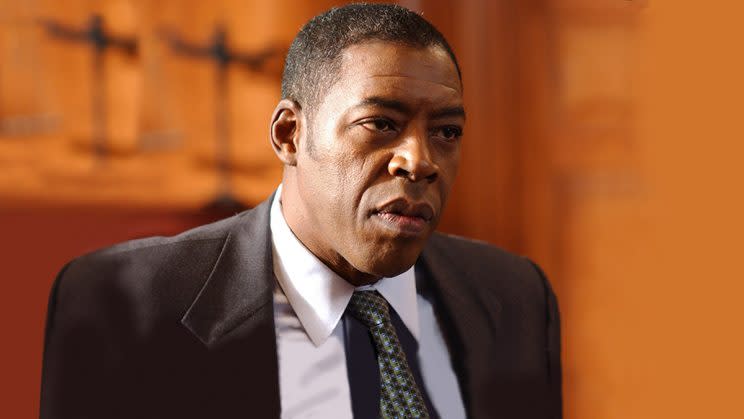
Hudson: I thought Leo was as balanced a guy as you can get under those circumstances, but I’ve heard people say, "He was the worst. He was an awful guy." I’m like "Really?" There was a website in the late ’90s where fans could give their comments, and I remember going online and some guy had said, "Leo seems to have a stick up his ass." That actually broke me of the habit. Even now, 20 years later, I don’t go online to find out what people think. The thing I take away from my character is — and I’m sure Tom would hate me saying it — but he was the dumbest warden! He was a well-intentioned warden, and he could be stern, but he never got to the bottom of anything. He had a murder a week and he never figured anything out. I’m like, "Can I just solve one of these frigging cases?"
De Segonzac: During the first season, there was only one accident, which I was the fault of. We were doing the riot scene in the Season 1 finale [which de Segonzac directed], and with 150 guys running around, you had to find someone each of them could do. Tergesen had the fire extinguisher and was spraying it all over the place. He was like, "Really?" and I said, "Yeah, it’ll be great, you’ll see." There was this one young guy — who I think in real life was a violinist and he somehow got a part on the show — the guards beat him up, and they put the cuffs on him behind his back. The scene felt like it was about to lose energy, so he screams at the guards, "Get them off!" They grab him by the arms, but he’s handcuffed and that’s exactly the wrong thing to do. Now the guy is squealing, and I thought, "Wow, that’s pretty f***ing good." But it turned out that the cuffs had cut him to the bone! I was very embarrassed.
Velez: I wasn’t in the riot episode at the end of Season 1, and that’s because Tom said, "I don’t want you to be in that episode." Because the prisoners talked about Dr. Nathan a lot, and would be like, "Oh, Nathan’s hot." He said, "I’m afraid it would have to get graphic. They’d wind up raping Gloria, and I don’t want that." Which I thought was very interesting. In some ways, it would have been predictable; you would expect that to happen to the character. But then she could never go back there and I think there were all those considerations as well. We’d have to lose her, because there’s no way she would come back to work in this prison. No way at all. Tom had the wherewithal to think about the totality of the show, and being able to see it going beyond what we saw.
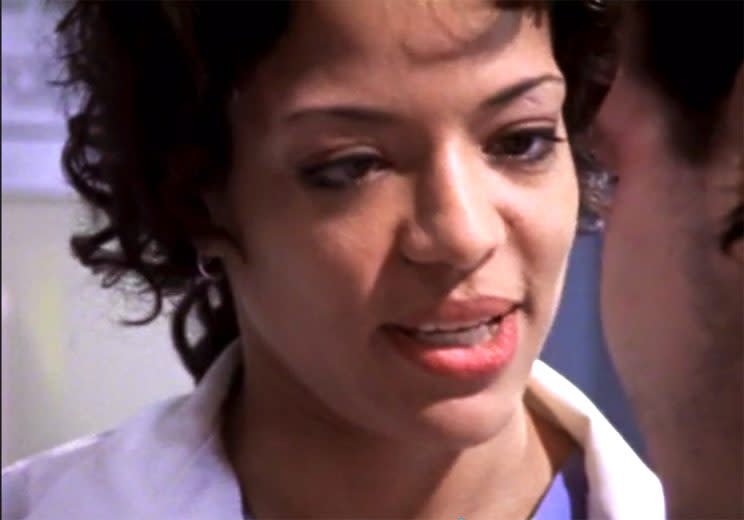
Acevedo: At the end of every season, what Tom would do is sit down with you and say, "How’d you feel about your arc? Where do you feel that you could’ve gone or that you maybe want to go next season?" I’ve worked with everybody, and no showrunner has ever done what Tom Fontana has done. The whole storyline in the third season about Miguel being too white and not Latino enough was something I brought up with Tom, because it was a big issue for me growing up in the South Bronx. He put all of that into the show.
McAdams: I just remember not wanting Johnny Post to go out like a punk. So I loved reading my death scene, and realizing they set him to go out in all his glory, cussing and fussing and telling people to kiss his ass. The fact that they decided they were going to chop his penis off and deliver it back as their message meant that I knew I’d spend the rest of my life being laughed at. My only request was that it was delivered in a big box, not a small box.
Velez: Tom was always really great about discussing where he thought something was going to go, and it was always in a very off-handed manner. At one point, we hung out and had steak and whiskey, and he said, "I’ve got something I’m thinking about, and tell me if it’s crazy. Would this woman ever fall in love with a prisoner?" And I said, "Absolutely." He said, "I’ve spoken to other women and they said no." I replied, "When you fall in love with somebody, sometimes you can’t help who that is. The more complicated the better. Please make that happen!" So she fell in love with Ryan O’Reily. I’ve never had a woman tell me that they didn’t buy it or that they thought it was inappropriate.
Fontana: Initially, we had a consultant who had been in prison, but he wanted to be a writer and he just would have preferred if I had just handed him the pen and said, "You can write everything." So that was very short-lived. All I can say is I that did two years of research, and I continued to read and talk to COs and ex-cons, so I kept having conversations about what was going on in prisons. The thing about prison is that no two prisons are the same, so I had a lot of room to make up s***. But I also took my responsibility very seriously; I didn’t want anything to be salacious or sensationalistic just purely for that. Anything that happened had to come out of character. On the other hand, you also find out stuff that really happened, like a guy who worked in the prison cafeteria hated this other guy so he fed him broken glass. My attitude was if something was real, then it was fair game. Oddly enough, as the series went, I would get yelled at for something I didn’t make up, but people assumed that I had made it up.
Albrecht: We were certainly put back on our heels a few times [by the content], and I don’t remember if we ever actually asked Tom to change something or just voiced our concerns about things. We really were charting new territory here. We had no idea what was possible to do, and the content of Oz was certainly beyond any of the content of the movies that were on HBO.

Winters: I’ll tell you one thing: I had two friends in prison during Oz, and they were like, "You motherf***ers got that s*** right." Prison is a microcosm of our society, and a lot of bad s*** happens in our society every day. I’ve been on panels where I’ve heard this question from some white guy whose face is melting into his khaki pants, blue blazer and red tie: "Oh, is this really [accurate]?" It’s like, go f*** yourself. Have you ever been in prison? Have you ever even visited a prison? Because I’ve visited prison, and it is not a cute place. There is some horrific s*** that happens there. I don’t think Tom went deep enough. He could have gone so much darker, because the stories that we heard while we were making this show, would never even pass the HBO censors. So, you know, suck on that.
Akinnuoye-Agbaje: In terms of the sexuality and sensationalism, there were occasions where I felt it was not always necessary. But then there are occasions where it would go there because it was written from an authentic place. I think there’s a wonderful balance, and Tom was always open to that collaborative dance. We all trusted Tom. We didn’t necessarily like him, and I mean that in the best possible way. He’d done meticulous research so you knew it was not just some flippant, sensational kind of thing.
Martin: There’s a scene with Schillinger after he’s branded Beecher where he’s just talking to him. I said, "You know what I want you to do? I would like you to have your shoes off and your foot in his lap, and you’re making him give you a foot rub." For some reason, that just seemed right. The branding had nothing to do with sex; it was about power. There’s such an intimacy to the foot rub, and J.K. just ate it up; he was tickling Lee with his toe. That scene explains to me, in a weird way, how I handled [the sexuality]. Sex, in general, is not an empty thing to me, and sex scenes are not about, "Lay on top of this person and bounce harder, and then it’s over." It has to be about something. Beecher probably massaged his wife’s feet, you know what I mean? So that scene is about something other than power, because we just played that beat with Schillinger tattooing the swastika on his ass.
Kinney: When the romance between Beecher and Keller started [in Season 2], here were two straight guys that were being asked to engage in a graphic depiction of a gay prison couple. They were a little bit shy going into it; one of the things that happened was that everything was out in the open. Everything was shot in a wide open space, so there was no sense of, "Hey, this is a private set." We would all stand at the monitors and watch this stuff. And they went for it. The whole dynamic in that building was "Go for it," and that’s what those guys did. What was surprising was how it caught fire. That was one of the first things that became a really popular element of the show. There were a lot of viewing parties for those two.
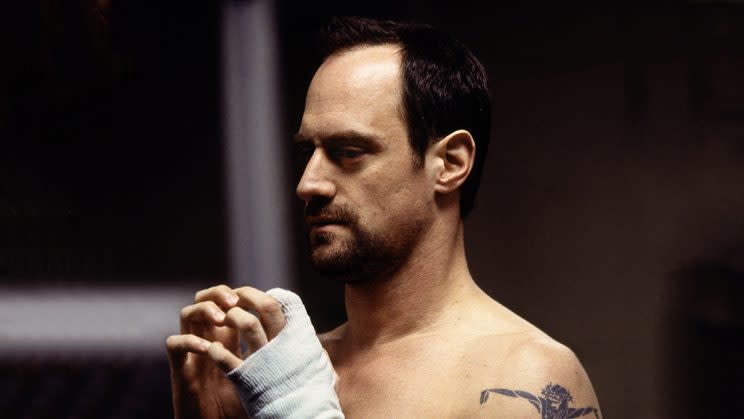
Tergesen: I loved the part of the show. In my opinion, it was never about them being gay, it was just about them being in love. If you can find love in a place like that, you’re lucky. My first memory of Chris is that he came to set for a costume fitting, and he was wearing a Tool shirt. And I was like, "This guy seems like a tool." I told him, "Listen man, let’s go have dinner." So we went out to dinner, and I said, "You’ve seen the first season, so you know we’re trying to push the envelope. I know the tendency is for two guys who are not gay to try and skirt around it, but I have a feeling we’re going to be doing a lot of this and I think we should try and make it sexy." Chris looked at me for 10 seconds and then said, "Wow." But I feel like we did that; there were some amazing moments of tenderness [between them], and I love that it was just about the love. The funny thing is, just as an aside, he and I went to a Tool concert the other night!
Acevedo: We worked together 12 hours a day, and then we would go out four to five nights a week with each other. We were all in our 20s, and we saw each other at work and after work. We all hung out with each other in general, but there was a devious mentality with the inmates. Adewale would get these scenes where it would be like "Adebisi rapes this guy," and we would be like, "What you going to do?" He would say, "I don’t know," so we would give him [advice]. Like, "I think you should grab him by the hair or rip his pants." That was the best part, because the material was so heavy and emotional. You can’t walk on set and be like that the whole day; you’d be so burnt out. It was easier to joke around during those moments.
Akinnuoye-Agbaje: There were several times when we had extras on the set where altercations would break out. They would! They were quickly broken up, but it was just the nature of the beast. When you’re being pushed to be as defensive as you can without actually being the actual prisoner, there were times when it would spill over. I know for myself, certainly with the guards or the warden, I wouldn’t mix with them. Because they were guards, you know what I mean? Many times there were blurred lines, and in the heated scenes you’d go overboard sometimes. That’s why you got such great chemistry and great work coming out of it.
Hudson: I knew Adewale [before Oz]. We shot the movie Congo in Costa Rica together and we became, I thought, really good friends. When I first got the show and found out he was going to be on it, I was like, "Great!" Then he became Adebisi and suddenly I go, "Who the hell is this guy?" He maintained that character for years. Towards the end, in the last couple of seasons, we went, "OK, we can let our characters go. We do know each other." There was about four years there where I don’t think I could even speak to him.
Velez: I remember the first time I met Adewale on set, he literally almost skipped towards me! He took my hand, and with the most incredible smile said, "I’ve been wanting to meet you." I was like, "What?" We just walked hand-in-hand across the stage just gushing about each other, and this is this guy who plays Adebisi! Take your pick between him and Schillinger about which is more reprehensible. I had the same experience with J.K. when he was in the infirmary. At one point, he was sitting there and he had the most beautiful, glowing smile. It was interesting. Sometimes in the beginning I couldn’t put two and two together between the actors and the characters.
Kinney: I went out with Adewale all the time. People would recognize him immediately because of that little hat and everything else. He’s a beautiful man. We’d go to bars, and he was quite popular. I hung out with everybody, especially Tom and his posse — Lee and the Winters brothers.

Winters: At the end of the day, we were all just a bunch of kids, even the guards. Most of us were new to this. You would want to think that there was animosity on the set between the guards and the prisoners, and there might of been a little tension off set here and there. But the truth of the matter was that we were just a bunch of golden retriever puppies in a storm box going bananas. In between scenes and during down time, there were guys break dancing, having a push-up contests, working on their one-man shows and reading poetry. It was really like the Royal Fontana Company, a kind of theatrical experience during the day. Tom and his crazy roving company of just insane bandits, just going, "What the f*** just happened?"
Chapter 6: What Oz Hath Wrought
By the time Oz ended its six season run in 2003, HBO’s ranks of original programs had swelled to include such era-defining shows as, The Sopranos, The Wire, and Sex and the City. The larger cable landscape had changed as well: Showtime had ramped up its originals slate with Soul Food and Queer as Folk, and in 2002, FX premiered The Shield. In several cases, these descendants overshadowed their ancestor in terms of ratings and awards. Still, 20 years later Oz remains a singular TV series, and a foundational experience for everyone involved in its making.
Fontana: HBO didn’t bother us with ratings. If they did marketing or demographic research, they didn’t share it with me. The thing that Chris said to me was, "I don’t care if this show is talked about in the TV section of the newspaper. I want it on the op-ed page." So anytime somebody on an op-ed page made a reference to the show, he considered that a 40 share of a Nielsen rating. He wanted HBO and the show in places where people who don’t watch television are looking. I had no idea what the ratings were; all I knew is that he said, "Let’s make more of them," and I said "Yippee."
Albrecht: I got a lot of comments [about Oz] from people who were my peers in the entertainment business, so I knew that people were paying attention to it. I think that was the first step towards having it be an impact. I don’t know how many subscribers we had at that time — 15 or 17 million maybe — but the fact that we were getting that kind that kind of attention for something that we had done for our programming strategies [told us] we were in uncharted territory. There was a bridge here we could continue to widen and build as long as we were prepared to make the investment.
Winters: Back in 1997, who had HBO? I didn’t. Did you? And given the content of the show, we were going to work thinking, "Are these people f***ing crazy? No one’s going to watch this."
Tergesen: Right before it started to air, a bunch of us had this thought, like, "Oh my God, what the f*** are people gonna say when they see this thing?" And there were definitely some people like that. One of my favorite reviews was a review that said, "This show offends God and it offends me." But then it came on, and it was such a great show. And it was a great show to be in New York doing, because people were so verbal. When the show was on, there was always a bunch of stuff happening with people on the street. People who had been to jail would be like, "Yo man, I love that show you’re doing, but I just gotta tell you — the sex stuff, it’s not like that." Like really bro? You need to tell me this on the street? I wasn’t thinking about whether or not you had sex in prison until you just brought it up now.
Hudson: I got a call to be on some talk show on MSNBC; the Monica Lewinsky thing was going on, and they wanted me to come on a panel to discuss Bill Clinton. I didn’t know why they asked me, but I go on the show and I say, "Well, you know, we all make mistakes." The commentator said, "That is not what you said on the show." Then it occurred to me that they actually thought I was a warden! They were dealing with it like I was this authority having worked in prison. I don’t know who did their homework, but I’m like, "I’m an actor. What I say on the show comes from Tom Fontana and the writers. It’s nothing to do with me."
Velez: There was some strange fan mail about outfits they wanted Gloria to wear. I was like, "Wow, this is just a little bit too much."
Acevedo: All of us would get mail from prisoners. I would get mail constantly. "You remind me of me. You remind me of my brother." Or, "Hey, can I get a job? Because I was really in prison and I know what’s up." Stuff like that. The one complaint that people did say was, "Goddamn, everybody’s so handsome in prison!" All of us were too good-looking to be in prison. We’re actors, though. I think probably none of us would survive in prison.
Fontana: I took the responsibility of doing the first drama series for HBO very seriously. Because when you’re given unlimited freedom in terms of language, sexuality, and visual storytelling, it’s very easy to go, "I’m free at last! I can do anything I want!" It was a real lesson for me to try to truly use the violence and the sex when I felt it was necessary for character stuff, and not just to put it in because I could. Not knowing who the next people at HBO doing drama series would be, I felt a responsibility to them. If I f***ed up, Chris would say to them, "I trusted Fontana and he f***ed it up, so I’m not trusting anyone after that." Fortunately, I didn’t f*** it up too much, and David Chase was the next guy in the door.
Albrecht: First and foremost, Oz was an "Open for Business" sign for HBO. But it wasn’t like all of a sudden the floodgates opened; it was still a growing process. Even The Sopranos was brought to us through Brillstein-Grey, because Brad Grey had been a dear friend of HBO for a long time. The idea that he was going to pitch a show to us was not unusual, but what was unusual was that it was an hourlong drama instead of Fraggle Rock or a comedy special.
Winters: When HBO got wind that hourlong programming could work, they greenlit The Sopranos and Six Feet Under, and then Oz kind of got lost in the conversation a little bit. I’ve always looked at that as a little unfair to Tom, because Tom really needs to be credited as the guy who literally broke down the walls of late night [original] programming for cable television. It’s not sour grapes at all, because those shows were amazing. All I’m saying is that Oz was the guinea pig, and guinea pigs usually get left out of the equation. But you’d have to be really academically bankrupt or just stupid to watch Oz and not see the bigger picture. In mean, in 1997, one of our lead characters was a Muslim. People are talking about Muslims on TV now, and we did it 20 years ago. Tom was so ahead of the game that it frightened people, and they’re just figuring it out now.

Kinney: All of us were resentful; that’s just the truth. The Sopranos came on, and we loved that show. I still do, obviously. We just really felt like the bastard cousin. We kept wanting recognition; we kept wanting marketing and publicity to put us out there more. We kept wanting to be put into at least the mainstream of cable, since we were the first cable drama ever. We were all working under the radar, and we were all wanting the radar to find us a little bit.
McAdams: Twenty years is a long time with multiple generation gaps, so there are a lot of people who just don’t really know the value of what this show meant to cable television. They don’t know how it set the foundation for all these other shows that came on HBO that everybody loved. Not just The Sopranos; I’m talking about shows like The Corner and The Wire. I was blessed to work on The Wire for a number of seasons, and people get more excited about me mentioning that then they do when I mention Oz. That’s because they don’t remember Oz.
Albrecht: I think maybe from the subject matter point of view, Oz was a tougher show to watch than a lot of the others, even though the others were groundbreaking in their own way. Oz was more violent, and that’s saying a lot compared to The Sopranos. Even in The Sopranos, you didn’t see people get killed a lot; they got killed off-camera. In Oz, the violence and stuff like that happened right in front of your face. The other shows were maybe easier on the stomach for people.
Tergesen: You now, whether Oz gets included in a list [of influential shows] or not, it doesn’t matter. I know what it was, and to this day, I find people are always stopping me and talking about it. So was The Sopranos a major hit? Yes. But it was part of a process. There wouldn’t have been a Sopranos if there wasn’t an Oz.
Akinnuoye-Agbaje: I think the very reason that we’re talking about it today shows that it’s not overshadowed. We were first, and Oz was probably an uncompromising show that was always going to be a hard pill to swallow. But what it has become as a result is a cult phenomenon. The Sopranos was slightly more commercial, and a little bit more palatable but Oz was uncompromising.
Martin: I think Oz was so far ahead its time, because it didn’t have a Tony Soprano. That was deliberate on Tom’s part, because he really wanted an ensemble piece and he loved this idea of the guy you love might die. In a weird way, Oz shot itself in the foot, because there’s nobody for you to hold onto. Tom would kill them off so quickly. You watch for the performances, but not for any one performance. That couldn’t work for a very long time, and now where do we see it working? Game of Thrones also has no Tony Soprano. Oz is the one that started that. It’s a very forward way of thinking, and now everyone’s thinking that way.
Fontana: Even though they were both about criminals, The Sopranos was so different from Oz that it wasn’t like it a copy of something we did. It existed in its own universe. I’m glad Oz worked for HBO, and gave them the courage to keep pushing the boundaries that it did with The Sopranos and Six Feet Under and all the shows that have come since.
Albrecht: I learned a tremendous amount by doing Oz. Tom was a consummate showrunner and supportive friend. There’s a real bond that’s made when you go through something like that. I’m incredibly proud of the show, and I always talk about it like Tom and Barry were a little like Lewis and Clark, looking down at the Pacific going "Holy crap, we made it."
De Segonzac: What I like about the show is that it’s completely timeless. Re-watching the first episode, it could be happening today. It’s also just a great memory of what filmmaking can be about, and the kind of feeling that happens if the people involved are given free rein.
Tergesen: Oz changed me in a lot of ways, and most of the time work doesn’t, you know? I learned a lot about myself as an actor, and I have a career that’s largely based on the fact that I did this show 20 years ago. I’m so happy that I got that chance, and the relationships that I still have to this day. When J.K. won the Oscar for Whiplash, I texted him, "Wow, I just realized I licked the boots of an Oscar winner." And his return text was, "If memory serves you also shit in the face of an Oscar winner."
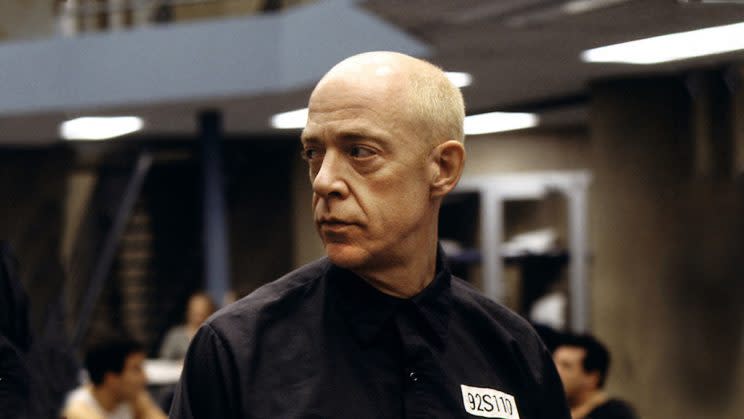
Akinnuoye-Agbaje: No matter where I go in the world, people will always call me Adebisi, and that’s cool with me because it’s been the foundation of my success. Whatever role I play is a result of writers, directors, and producers watching Oz. And I think it made people aware of what goes on behind those bars. I was invited to Rikers to speak to some of the younger offenders in there, because the prisoners were some of the most popular viewers of the show, and felt that it was an authentic voice as far as it could be.
Seda: Every now and then, someone will be like, "Hey! I love Dino, man. It was the best character. Why’d they kill you?" I’m like, "Aw, thanks." It’s great to be a part of something that when you pour so much into and you get so much passion in your heart. It was just a great project to be a part of.
Acevedo: This is gonna sound so mushy, but Oz was the truest sense of an artistic family that I could ever, ever have. I was in New York two months ago, and I had drinks at Tom’s house. I still talk to most of the guys. So there’s that sense of family, and other actors looking out for you. This whole business is really not forgiving, so for that to be one of my first jobs spoiled me. When I go on any other show, and I see a guest star come on the set, I think about how nervous I was [on Oz]. So I try to be as welcoming as possible. I go, "If you want to ad lib, throw it at me." I make them feel that it’s OK to f*** up.
Velez: This truly was a family. You hear people say that, but I just remember hanging out watching people’s scenes, and I remember the level of commitment to the work and to the collaborative spirit. You don’t get that often in your career. It made me a better actor and gave me something that I’m proud of to be a part of. And I met some great people that I love.
McAdams: Oz set the foundation for what my career is today, working as a professional stuntman. That only happened because of the exposure I had to the stuntpeople that I met on Oz. It changed my family’s life, too, because when I left New York and went back to Maryland, the dream was real at that point. Oz showed me what was possible in life, and the belief system and faith that I gathered built my confidence for everything else I’ve been able to accomplish.
Hudson: For me, Oz brought a certain integrity and honesty that touches you on a deeper level. It was the most amazing cast I think I’ve ever worked with.
Winters: I’ve been on a lot of great shows, but Oz is the biggest, baddest motherf***er I could ever have been a part of. That was a period of time that will never be repeated, and for that I’m eternally grateful. Plus it was where I got my chops: I learned how to fail, and I learned how to succeed. Nothing will ever come close to it, ever.
Kinney: I have two personal legacies that really shaped my entire being as an artist. One is my theater company, Steppenwolf, which shaped the way I see the world through art. The second thing is Oz. Tom gave me the language for filmmaking and that side of things, and the idea of having one person be the captain of the shop. Tom was the great decider for all of us, and that really shaped so much of how I treated everything after that as an artist. I don’t do anything unless I think it has that kind of vision now. Because of Tom, my standards were raised, and I think all of ours were.
Fontana: As a writer, Oz liberated me in a way that I didn’t know that I needed to be liberated, in terms of how to tell stories and how to develop characters. On a personal level, being friends with the cast has enhanced my life. I get asked every couple of weeks when I’m bringing the show back. But the sets are gone and the actors are all too expensive, so there’s no chance of it. I couldn’t afford Dean Winters or J.K. Simmons anymore! So I can’t say that I sat up night cursing the darkness that we didn’t get the recognition [at the time]. What’s funny is that it’s taken 20 years, but now everybody’s saying that. You know what I mean? I lived long enough to hear it.
Oz is currently streaming on HBO Max.


